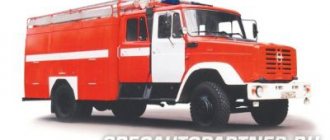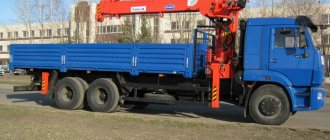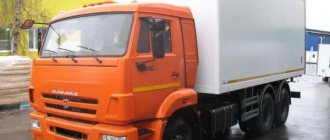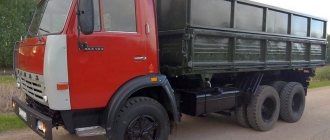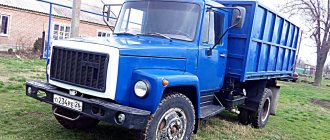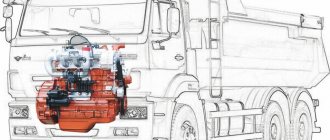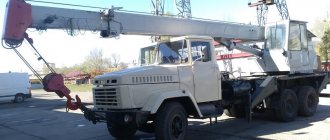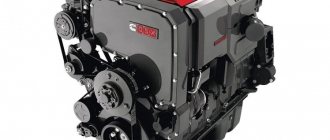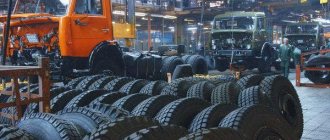Comparative table of CMU loading capacity characteristics
| Name of CMU | Freight moment | Load/lift at min. reach | Load/lift at max. reach |
| KAMAZ 65117 with CMU FASSI 110A.0.22 | 10.70 tm | 5280 kg - 2.00 m | 1325 kg - 7.90 m |
| KAMAZ 65117 with CMU FASSI F155A.0.22 | 13.56 tm | 6160 kg - 2.15 m | 1660 kg - 8.00 m |
| KAMAZ 65117 with CMU FASSI F175A.0.22 | 16.00 tm | 7850 kg - 2.00 m | 1955 kg - 8.05 m |
| KAMAZ 65117 with CMU FASSI F175A.0.24 | 15.09 tm | 7535 kg - 2.00 m | 1005 kg - 12.30 m |
| KAMAZ 65117 with CMU FASSI F195A.0.22 | 18.86 tm | 9200 kg - 2.00 m | 2315 kg - 8.05 m |
| KAMAZ 65117 with CMU FASSI F195A.0.25 | 16.11 tm | 8065 kg - 2.00 m | 825 kg - 14.35 m |
| KAMAZ 65117 with CMU FASSI F215A.0.22 | 18.86 tm | 9200 kg - 2.00 m | 2315 kg - 8.05 m |
| KAMAZ 65117 with CMU FASSI F245A.0.22 | 23.45 tm | 8900 kg - 2.50 m | 2915 kg - 8.05 m |
| KAMAZ 65117 with CMU INMAN IM -150 | 12.10 tm | 6050 kg – 2.00 m | 1320 kg – 8.40 m |
| KAMAZ 65117 with CMU INMAN IM -240 | 21.90 tm | 7300 kg – 2.00 m | 2900 kg – 7.58 m |
| KAMAZ 65117 with CMU INMAN IM -180 | 17.90 tm | 8800 kg – 2.00 m | 2200 kg – 8.00 m |
| Name of CMU | Freight moment | Load/lift at min. reach | Load/lift at max. reach |
| KAMAZ 65117 with Kanglim 1256 | 15.0 tm | 2.0 m – 7000 kg | 18.7 m – 300 kg |
| KAMAZ 65117 with Kanglim KS2056H CMU | 18.0 tm | 2.0 m – 7100 kg | 20.3 m – 350 kg |
| KAMAZ 65117 with Dongyang SS 1506 CMU | 15.00 tm | 7000 kg – 2.00 m | 370 kg – 19.4 m |
| KAMAZ 65117 with Dongyang SS 1926 CMU | 19.00 tm | 7000 kg – 2.70 m | 400 kg – 19.80 m |
| KAMAZ 65117 with Soosan SCS 736 CMU | 15.00 tm | 6000 kg – 2.00 m | 350 kg – 18.8 m |
| KAMAZ 65117 with CMU INMAN IT-150 | 15.00 tm | 6600 kg – 2.00 tm | 300 kg – 19.0 m |
| KAMAZ 65117 with CMU INMAN IT-180 | 18.00 tm | 7200 kg – 2.50 m | 400 kg – 18.8 m |
| KAMAZ 65117 with Unic UR V-504 CMU | 12.4 tm | 3030 kg – 2.50 m | 830 kg – 10.84 m |
| KAMAZ 65117 with Unic UR V-554 CMU | 12.1 tm | 5050 kg – 2.00 m | 750 kg – 11.25 m |
Cargo mathematics and truck crane frame
The frame of the medium-haul KAMAZ-65117 is additionally reinforced with a special superstructure subframe. Since the load capacity is determined not so much by the endurance of the chassis, but also by the supporting frame, the subframe wraps around the truck frame and is used as an additional element of chassis rigidity during lifting operations, reducing torsional loads on the frame.
The crane pedestal does not eat up much useful space on the frame, leaving 7 m for the loading platform. Is this a lot or a little?
A simple calculation shows that with a loading platform width of 2.4 m and a building stone density of 1–2 tons per cubic meter, the machine is capable of transporting 17–24 tons of bricks, cinder blocks and foam blocks on cargo pallets in one tier only 1 m high! This even exceeds the capabilities of the machine, which was not originally designed for construction work.
A long boom is also useful for the most accurate delivery of cargo to the second, third, fourth and even fifth floor of a building under construction or to the roof of a low-rise building up to 20 m high. However, at the maximum reach of the boom, a standard brick pallet will have to be lightened by more than a third - from 1200 to 350 kg. So you will have to perform a couple of extra work cycles. Overload at critical heights and boom radii is controlled by an electronic locking system.
Safety and stability during work are ensured by telescopic outriggers (extendable side supports), which provide a wide support contour of 25 m2. But there are subtleties here too. If the front supports are a direct part of the base of the Soosan 736 LII loader crane and are located above the truck frame, then the rear supports are mounted under the frame. As with full-fledged truck cranes, the extension and unfolding of outriggers is carried out using a hydraulic drive, and the operation of the side supports can be controlled from both the right and left sides using a remote control.
The machine turned out to be optimal in all respects: it is, of course, not a tower crane, but it is no longer a hydraulic manipulator. The car subtly resembles an expert in a tailcoat... a long-range expert...
The editors thank you for the provided car.
Technical characteristics of KAMAZ-65117-6010-78 with Soosan 736 LII crane
| Wheel formula | 6x4 |
| Load capacity, t | 12,0 |
| Gross vehicle weight, t | 24,0 |
| Gross weight of the road train, t | 38,0 |
| Turning radius, m | 10,7 |
| Engine | Cummins 6ISBe300, turbodiesel, I-6 |
| Working volume, cm3 | 6678 |
| Power, l. With. | 296 at 2500 min-1 |
| Torque, N.m | 1100 at 1200–1800 min-1 |
| Transmission | ZF 9S1310 mechanical |
| Number of steps forward/backward | 9/ 1 |
| Tires | BEL-95, 11R-22.5 |
| Climbing angle, not less, % | 25 |
| Maximum speed, km/h | 90 |
| Weight of Soosan 736 LII crane, kg | 3814 |
| Outrigger reach, m | 5,35 |
| Arrow | 6-section, 6-sided |
| Boom radius, m, min/max | 3,64/ 18,8 |
| Height of lifting hook above the ground, m | 20,8 |
| Load moment, tm | 15,0 |
| CMU load capacity, kg, with outreach 2.10/18.8 m | 7000/ 350 |
| Hook lifting speed, m/min | 14,0 |
| Rope type | 10 mm x 12 m, non-rolling, 19x7 |
| Boom lift angle, degrees. | 1–78 |
| Column rotation angle, degrees. | 360 |
Atlant-S hydraulic manipulators
According to experts, in developed countries more than twenty percent of flatbed trucks are equipped with “hydraulic arms”, since they have already proven economically that it is more profitable to use hydraulic manipulators than truck cranes. Despite the fact that hydraulic manipulators have been produced in Russia for quite a long time, only now is the market actually realizing the capabilities of these mechanisms.
One of the main manufacturers of hydraulic manipulators is the machine-building plant from Maykop, which produces a line of manipulators under the Atlant brand.
Having specialized for a long time in the supply of manipulators for the forestry and wood processing industries, the developers came to the conclusion that the market for manipulators is much wider and launched a new series of Atlant-S hydraulic manipulators.
note
This modification allowed Atlant-S manipulators to take their rightful place in construction, housing and communal services, and in the operation of water and railway transport. To cover different areas of use, manipulators can be equipped with various special load-handling devices.
If we talk about the operational and technical characteristics of Atlans-S hydraulic manipulators, then first of all I would like to note that especially strong 09G2S steels are used for their production
Taking into account its importance, the hydraulic system uses components from Italy (HCD 6/6) and Sweden (RM-316)
To protect the hydraulic system, pressure, drain and safety valves have been introduced. With a low weight (from 1600 kg to 2170 kg), they develop a load moment of up to 140 kNm, which allows them to successfully compete with the best examples of well-known manufacturers.
The mechanized raising and lowering of the outrigger supports greatly facilitated the operator’s work. The unification of mounting dimensions allows the GM to be installed on the chassis of many widely used trucks.
Since 2007, the plant began producing operator cabins. The new model of hydraulic manipulator LV 185-14 is equipped with a cabin in the basic version. The cabin is small in size, but provides minimal comfort for the operator. Heating is provided, good visibility and easy control using joysticks.
The low price of Atlant-S hydraulic manipulators (about 500-600 thousand rubles depending on the modification, but this does not include the cost of the chassis vehicle) allows you to pay for the equipment in the shortest possible time.
equipment hydraulic manipulatorsReviews
Modern chassis with joint ventures
After 5 years of production, the new family of medium-haul trucks KAMAZ-65117 no longer raises even a shadow of doubt among cargo carriers. Disadvantages have been discovered, illnesses are known and can be solved financially. This is evidenced by high liquidity in the secondary market. The annual loss in value of individual models is close to the European average - only 12–18%.
As a result of deep modernization of previous generation KAMAZ vehicles and adaptation to modern transportation conditions, the “65117” family has been optimized and improved in all respects. Having become more powerful, more spacious, more load-carrying and more comfortable, the car demonstrates an increased average speed and economical movement during urban and suburban use in comparison with its predecessors. Four factors contribute to the improvement of these indicators: improved ergonomics, reduction of unsprung masses due to the transition to disc wheels, a less vibration-loaded engine and a lightweight frame.
The legendary V-shaped “eight” KAMAZ-740 with a power range from 320 to 420 hp. today it is more relevant for heavy chassis, tractors and dump trucks of the 6520 and 6460 families. And for trucks with a gross weight of up to 26 tons, the Kama auto giant today offers lighter, more economical and compact in-line 6-cylinder turbodiesels from the JV CUMMINS KAMA JSC.
When idling, the Cummins 6ISBe300 emits a very measured and muffled diesel rumble, as if the sound was coming from a car parked twenty meters away. To immediately dispel the statements of skeptics about the Chinese origin of the engine, I note that the casting and processing of the main engine parts, such as the cylinder block, cylinder head and crankshaft, takes place at CUMMINS KAMA. High-quality elements of the cylinder-piston group are produced by the Federal Mogul KAMA joint venture. But in general, localization - the level of components produced in the Russian Federation for these engines - reaches 60%.
Thanks to the use of a modern and economical Common Rail fuel system with electronic control, from a 6.7-liter engine it is possible to produce from 185 to 300 hp, easily meeting Euro 3 and even Euro 4 environmental standards.
The gearbox and motor are manufactured in Russia at the CF KAMA joint venture in Naberezhnye Chelny. This is a 9-speed manual ZF 9S1310 Ecomid series.
Used or new CMU?
There is no full-fledged “trade-in” market (acceptance of old CMUs against the cost of new ones) in Russia yet. Official representatives of the main Western manufacturers of manipulators are not yet engaged in the sale of used cranes and trade-ins. In Russia there is a very great need for inexpensive used manipulators. However, in Europe, prices for used manipulators are quite high: a manipulator loses half its value only after 10...12 years of operation, since little wears out in manipulators during operation. It is usually difficult to establish the true operating time and condition of such a manipulator; identification plates can be replaced, and the entire risk of further use falls on the owner. The only thing that makes the situation easier is that servicing the CMU is not difficult and the owner can do it himself: just change the oil and filter regularly. Therefore, the import of used CMUs to Russia has not gained popularity. In Russia, everyone usually uses manipulators to the end and does not sell used ones. If a used manipulator is still sold with a Russian chassis, then the problem, as a rule, is in the chassis, which wears out more than a foreign manipulator. Therefore, the market for used manipulators has not yet formed.
Owner reviews and prices
The cost of a used car, a new version, is from 1,000,000 rubles. In addition to the basic equipment, you can install an audio system, a walkie-talkie and effective fog lights. In some cases it is worth conducting a comparative analysis. If the purchase and rental prices are not comparable, then it makes sense to obtain temporary ownership of the vehicle.
Alexey, 40 years old, Perm: “The car has been in service for 2 years. No difficult problems arose during this time. The main thing is to maintain the car on time, change the oil, and keep an eye on the details. I was pleased with the sleeping place, which was not available in previous models. Now you can comfortably travel long distances in KamAZ.”
Nikolay, 39 years old, Voronezh: “I have already driven this car for 100,000 km. The technical characteristics are not satisfactory. The engine and other main elements operate stably. There were no problems starting in winter.”
Would you recommend buying a KamAZ flatbed truck model 65117?
KAMAZ 65117 crane with Kanglim 1256 crane
There is a discount of up to RUB 625,000! Call for details! We work throughout Russia! Delivery!
Crane units (CMU) based on KamAZ are multifunctional equipment widely used in various spheres of the national economy. The chassis of the KamAZ vehicle is distinguished by increased cross-country ability, which, in combination with the installed crane-manipulator unit, makes it a popular mobile complex capable of guaranteeing the successful completion of work both in urban conditions and on rough terrain.
Universal crane vehicles (CMU) based on KamAZ, capable of providing profitable savings of time, effort and money, are widely used by construction, electrical installation, logistics and other companies. One unit of special equipment replaces a large-tonnage truck and a powerful truck crane, controlled by a single person - a driver-operator. The popularity of crane installations based on KamAZ is due to their unique capabilities - a vehicle with a lifting capacity of more than 5 tons allows you to successfully install and safely operate compact cranes designed to work with loads weighing up to 8 tons.
Modifications of the all-terrain vehicle KamAZ 43118 are used as the wheelbase for installing the cable-type CMU, the onboard KamAZ 65117 is a long vehicle with a 6 by 4 wheel arrangement, KAMAZ 65115 with all-wheel drive 6 by 6 or 6 by 4. Vehicles of this class are equipped with an all-terrain chassis, a winch and a diesel engine. engine whose power reaches 300 hp. With. A crane unit mounted on the chassis of such a truck is capable of not only lifting and lowering heavy loads with high precision, but also ensures their movement in the horizontal plane to any required angle. In addition, any crane-manipulator based on KamAZ is a self-loader and unloader capable of transporting various cargo over long distances.
CMUs equipped with a special cradle basket are no less popular. The length of the fully extended lifting arm of some models of loader cranes is more than 20 meters. This solution allows employees of electrical installation companies to safely install and repair power and communication lines in difficult places in the shortest possible time.
All modifications of crane machines have successfully passed verification tests, have a set of appropriate documentation and are fully ready for further operation in any region of Russia.
Source
Video instructions for installing the CMU (Crane Manipulator Unit).
Symbiosis in technology and business
To perform individual work on construction sites or in the road sector, until the 1960s, only highly specialized types of equipment were used. Even the simplest symbioses implied the use of at least two types of equipment: a truck crane and a flatbed truck, an excavator and a dump truck, a scraper and an earth carrier...
The growth of industrial and capital construction and mechanization had already reached its limit by that time, but it also required highly qualified drivers, mechanics and maintenance personnel. Thus, in the 1950s, economists were faced with a paradox: the daily intensification of the use of highly specialized equipment doubled and even tripled the costs of maintaining the fleet, even with constant employment! The bottleneck in construction logistics has become the key moments between the delivery of goods and its accelerated loading and unloading. Universal machines, capable of combining several properties, suggested themselves. The most successful applications have been found in hydraulic manipulators and hydraulic manipulators on truck and tractor chassis.
If in 1980, CMU on cars was used in the municipal and road sectors, forestry and oil and gas industries only for specialized purposes, then by the 1990s, small companies and cooperatives literally got rich using cars equipped with CMU.
The symbiotic heyday came in the mid-2000s. And now large construction projects with an extensive, narrowly functional and expensive fleet of equipment are already unthinkable without small subcontractors using wide-profile equipment with competitive prices for their services. The symbiosis of corporate and private business has clearly demonstrated itself in the field of low-rise construction, public utilities and road maintenance, where trucks with CMUs play an important role in logistics. But... our case is special!
Application of truck cranes
A truck mounted crane is a truck that is equipped with a CMU. This technique is most widely used in the construction industry. It is used for transporting various building materials - reinforced concrete products, pallets with bricks, etc. In addition, such equipment can be used as a replacement for a full-fledged crane when it comes to the construction of low-rise buildings. It is also successfully used during repair and construction work of various types, during landscaping or road work.
As for the reviews about this technique, they are very different and highly depend on the chosen model. For example, the Amco Veba model. The owners describe it as a comfortable car with good load capacity. The advantages also include the fact that the load does not swing during transportation, and it is also possible to install additional equipment. The disadvantages include the lack of a winch, as well as difficulties in lowering the load to a precisely defined place if it is located above the car itself.
Main components of the CMU
The crane in question is equipped with a rotating mechanism. It consists of the following main parts:
- slats of the rotating device;
- self-centering pressure plate .
All components are made of high-strength steel, resistant to corrosion and wear. That is why the service life of the CMU in question is very long - the working parts, even with constant exposure to heavy loads, practically do not wear out.
Fassi F245A.0.22 is also equipped with special traverses located at the boom joint. They perform the following functions:
- maintain the lifting moment (it always remains constant regardless of the load);
- increase the static power of the loading device;
- increase the lifting dynamics.
The main supporting structure of the loader crane is a boom made of low-alloy steel. It consists of pipes of variable cross-section.
There is not only a difference in overall dimensions, but also in shape. This is a consequence of the strengthening of the structure; in places of greatest load, the cross-section of the boom is maximum.
Peculiarities
To organize the transportation of objects and structures using a manipulator, it is worth knowing what kind of vehicle it is. A manipulator (or CMU) is a flatbed truck equipped with a special boom (mini crane) for performing manipulations with loading and unloading cargo. CMUs are in great demand among many transport companies, as they have an impressive carrying capacity (about 15 tons) and allow loading and unloading work to be performed faster, but with lower financial costs. Using the CMU, they most often transport:
- garages;
- cabins;
- cars;
- long structures;
- building materials;
- mail containers.
Of course, the list of luggage is not limited to the stated items; it all depends on the capabilities of the manipulator.
To deliver to KMU, you must consider:
Load capacity. Depending on the type of luggage being transported, in most transport organizations you can choose a vehicle that matches the cargo capacity (from 3 to 25 tons). This is most relevant in the case when large or heavy objects and structures are to be transported. Boom Reach
The distance to which the boom of the CMU lift extends is important. This function is noted as one of the most important when choosing a vehicle
Reach length is the maximum distance from the vehicle that a load can be lifted. In some varieties this length reaches 20 meters. Body dimensions. Length, width, height of sides. When transporting materials for construction, timber, and agricultural products, length and height are very important. When delivering large or heavy loads or mounted structures, the width of the body, or rather its numerical value, is required. Type of move. Depending on the terrain where the use of a crane is required, the type of travel influences. Wheeled or tracked. In conditions of poor traffic or timber extraction, caterpillar transport is relevant. Of course, such cars are most often found in mountainous regions and Siberia. Patency. Some regions require delivery of necessary goods or materials across the water surface. In small quantities, but still there are CMU amphibians capable of moving both on land and on water.
Device
The exterior design of the vehicle is distinguished by functional details and attractiveness.
This is a recent development of the company, which combines reliability, durability and increased load capacity.
The KamAZ onboard vehicle is in demand among Russian companies, as well as in regions near and far abroad.
Experts call this car a second chance for the Russian automobile industry. The distinctive features of KamAZ of this modification also include an elongated body, which allows transporting a larger amount of cargo, and a modernized rear suspension with springs of a new design.
Technical characteristics of the CMU
The main characteristics that determine the application possibilities and price of loader cranes:
- maximum and minimum boom reach;
- load capacity at maximum and minimum reach;
- load moment of the boom, also determined at the maximum and minimum values of the crane boom radius;
- height of lifting and lowering of cargo;
- minimum turning radius of the crane installation;
- suspension design.
Another important point is the design features of the boom:
- cross-sectional shape. It can have four, five, six or eight edges - the more there are, the stronger it is;
- type of telescopic extension system: sections can be extended either sequentially or randomly.
For truck-based loader cranes, important characteristics will be the load-carrying capacity of the side, the length and width of the loading area (i.e., the maximum dimensions of the cargo being transported), and the outriggers (supports) used, on which the crane’s load-carrying capacity and operational safety depend.
Rice. 1. Load-height diagram of hydraulic manipulator LV 220 – 01
When choosing a manipulator, it is recommended to pay attention to the load-height diagram (Fig. 1)
It displays all the capabilities of the crane and allows you to evaluate it based on the combination of the above parameters.
Faucet without fuss or manipulation
The Soosan 736 LII crane unit, located between the cabin and the onboard platform, is presented as a CMU, which is fundamentally incorrect. It's really a crane, but without a manipulator. It has a stand mounted on the chassis on a turntable, hydraulic cylinders for lifting a 6-arm telescopic boom and a rope winch. The lifting and lowering of the load is carried out using a chain hoist. Instead of a cabin there is an open operator's station. Instead of a counterweight there is a support contour and the mass of the machine.
The specialists of KRAN Center KAMAZ LLC chose this scheme not by chance, since the South Korean company Soosan does not welcome parasitic articulated joints and works in the narrow budget sector of proven and trouble-free technologies. The L-shaped design layout is more reliable and resistant to shock and torsional loads compared to knee Z-shaped CMU models.
Targeted delivery of cargo onto narrow working platforms requires the operator of the hydraulic manipulator to have the dexterity of an octopus, an accurate eye and reaction when handling the remote control. But crane installations, even with a single-string rope reeving, significantly expand the functionality compared to traditional cranes in terms of the accuracy of raising and lowering the hook strictly vertically. In combination with a high-mounted control station, this allows you to work on ultra-precise installation work not only at height, but also at depth - below the level of the machine.
The length of the crane boom in relation to the length of the truck's onboard platform is selected taking into account the use of the maximum reach when loading cargo from the rear. This can be useful when working on cramped construction sites, during urban operation in public utilities and road work, when the width of the work site is limited to one lane.
Delivery organization
Still, most standard cargo is transported using conventional trucks. Transportation of oversized, bulky or heavy objects requires preliminary consideration and approval from regulatory authorities.
Therefore, when drawing up a travel route, it must be analyzed and submitted for approval to road safety control services.
Preparatory activities are carried out taking into account the following criteria:
- details of the loading and unloading of the vehicle;
- transportation kilometers;
- characteristics of the cargo (length, width, height, volume and other values);
- marking of cargo by hazard class, if any;
- exact coordinates of loading, unloading and reloading points;
- serviceability of the road surface along the entire length of the route;
- the presence of complex or bottlenecks in the passage of crane trucks with oversized cargo, detour routes;
- reliability of fastenings for the fixation scheme of the transported object on the manipulator platform;
- proper placement of cargo in the body of the crane in accordance with the regulations for the transportation of oversized cargo;
- appropriate marking of the vehicle and cargo, warning other road users about the type of cargo being transported.
Also among the mandatory points for drawing up the route, it is worth noting the accuracy of the location of control points for inspection of cargo and vehicles, as well as their distance from populated areas.
Car manipulator configurations
Tow trucks
Designed for moving broken cars. The manipulator CMU is mounted on a durable metal platform. Loads are captured by a spider traverse, which contains a device that controls the horizontalness of the load. To prevent the installed car from rolling away, the platform has 4 built-in stops for each wheel. For additional securement of the transported equipment, there are special belts attached to the platform eyes.
Log carriers
These manipulators are designed for transporting large cargo, up to 6 meters. Usually these are lumber and rolled metal. The body is equipped with a protective shield enclosing the cabin and bunks for securing materials. The driver controls the CMU from a special seat, there is a rotator and a powerful grip.
Metal carriers
Designed for loading and unloading and transportation of scrap metal and bulk metal. They are distinguished by high and durable sides.
Dump trucks with CMU
Designed to work with various bulk materials. The CMU is equipped with a powerful grab. The sides open from the sides and rear, up to 130 degrees. The side walls are equipped with hinges, thanks to which bulk materials are neatly poured along the axis of the car.
Other manipulators
There is another classification of manipulators, according to which they are divided into:
- all-terrain vehicles;
- with grab;
- with winch;
- with cabin;
- with platform;
- onboard;
- with trailer;
- rotary;
- loaders;
- trucks with manipulator;
- towers.
To prevent your manipulator from breaking down at the most inopportune moment, it needs to be serviced in a timely manner and its condition monitored. For questions regarding the repair and maintenance of manipulators, you can contact our service center, and we will quickly, inexpensively and with a quality guarantee perform all the necessary work.
Additional installation options
All Fassi cranes, including the F245A.0.22, can be optionally equipped with various types of equipment:
- additional telescopic sections;
- shortened outer boom;
- hydraulic type single file;
- hydraulic type supports;
- hydraulic hoses in a special protective sheath;
- inverse hydraulic supports;
- distributor S800 (fully proportional);
- Extra Fast;
- XP.
Additional boom sections are often necessary to perform work at a great distance from the location of the CMU itself. If necessary, you can purchase and attach up to 6 additional sections.
The maximum hydraulic reach will be 17 m.
A short boom is also often required. Products of this type are labeled as AC. They are used to perform various types of work with large-sized cargo.
In some cases, hydraulic hoses with a special protective sheath are required - Internal Chain Guided Hoses. This type of option is indispensable if work is carried out in very difficult environmental conditions, for example, with sudden temperature changes.
Read about the design of the rotation and lifting mechanism of the KS-45717-1 truck crane and its other technical characteristics in our article. We have prepared for you an overview of the technical characteristics of the KamAZ-65116 truck tractor and its numerous modifications.
By clicking on the following link https://spez-tech.com/tehnika/stroitelnaya/kranyi/bashennii/kb/harakteristiki-405.html, you will find a lot of useful information about the KB-405 tower crane.
The material used in the conventional hoses supplied as standard on the F245A.0.22 may be damaged by heavy use in these conditions.
Reversible hydraulic mounts are necessary if the CMU needs to be installed on another base in the future.
The presence of this option makes it possible to place the crane on almost any equipment. There is no need to make any modifications or purchase a new crane.
An option called Extra Fast allows you to perform all kinds of loading work at very high speed. The increase in this characteristic occurs due to a modified power take-off shaft.
It has different overall dimensions and gear ratios than the standard ones, which gives an impressive increase in torque. Also, the power and speed of operation can be increased by the optional XP system.
CMU folding type
In Europe, CMUs of an articulated design with a Z-shaped folding pattern have become widespread. In the transport position, the boom is located in the transverse plane of the vehicle behind the cab. When installing a Z-shaped crane behind a truck cab, the entire weight of the crane falls on the front axle (i.e., it can be overloaded).
In Japan, South Korea and the USA, L-shaped cranes with a straight telescopic boom and a cable suspension of the load hook are more popular. They are typically used for loading and unloading the base vehicle and sometimes a trailer. For an L-type CMU, the boom is located above the body along or against the machine. Thus, it can interfere with the placement of a high load in the body and will not allow the load to be loaded “with a head”. But with this arrangement, the mass of the CMU is partially redistributed to the rear axle and does not load the front axle. The L-shaped crane has a long first boom section that cannot be folded, but short telescopic sections. Such a crane operates at long reach (6...8 m) faster than a Z-shaped one.
It is sometimes said that L-shaped CMUs, unlike Z-shaped ones, have fewer nodes and hinge joints, so their design is simpler and more reliable. This is not a completely fair statement. L-shaped CMUs have a rather complex design of the telescoping mechanism, so repairing the extension cylinders can be labor-intensive and costly.
A straight L-shaped boom cannot bypass an obstacle, such as a vertical wall, which a cranked Z-shaped “colleague” can easily overcome. However, there are booms that combine the advantages of L- and Z-shaped designs: their first two sections have a hinged connection, the subsequent sections are telescoped from the second. This type of crane has more degrees of freedom than a classic L-shaped one.
It is difficult to say for sure which of the structures is heavier - L- or Z-shaped. Due to the presence of "overlapping" sections, the telescopic boom of an L-shaped crane can be heavier than a Z-shaped one. However, in a Z-shaped boom with high lifting capacity, powerful connecting hinges can greatly weigh down the structure, so in each specific case, when choosing a crane, its weight should be considered separately.
In general, L-shaped hydraulic units are more highly specialized (for example, if a truck with an L-shaped hydraulic unit with a long boom is used for installation work) than Z-shaped ones, and therefore are not in particular demand in Russia (new). Only inexpensive Japanese and South Korean used L-shaped hydraulic units are common, and many of them are purchased together with used trucks. In cities, Z-shaped construction cranes and metal hydraulic manipulators are in greatest demand.
Advantages and disadvantages
Like any means of transportation, loader cranes also have positive and negative sides. Among the advantages are:
- The hydraulic mechanism allows you to perform any operation more gently than a conventional crane with a metal boom. Loading and unloading of vehicles is carried out with minimal losses and defects, or with their complete absence, which is almost impossible to achieve with a clumsy crane.
- Increased maneuverability of the CMU boom during loading and unloading operations.
- Cost of services. Renting a crane will cost a little more than a regular truck without additional loading equipment, but significantly cheaper than hiring special loaders or other additional devices.
- Possibility of continuous operation, since there is no need to wait for the arrival or repair of additional technical equipment.
However, despite such impressive positive functions, the CMU also has negative aspects:
- The reach of the boom affects its lifting capacity. The operating power of a lifting boom directly depends on the distance of its full extension. This dependence manifests itself in a decrease in lifting power with increasing boom length. This point should be taken into account when ordering a vehicle.
- Expensive repairs. A chance to save on the cost of a service or inattention when calculating the required cargo capacity can lead to a malfunction of the manipulator hydraulics.
Taking into account the nuances of the operation of the CMU and the interest of the service recipient in minimizing unpleasant consequences, it is still recommended to comply with the technical requirements when working with this vehicle, avoiding use at maximum values.
Operation and repair
The operating manual contains basic information about the transport mechanism, preparing it for operation, rules and frequency of maintenance, main malfunctions, and error codes. Following the manufacturer's recommendations will extend the life of the equipment. Main faults:
- the engine does not start;
- the engine does not develop the required power;
- extraneous noise;
- whistling;
- increased oil or fuel consumption;
- knocking when the engine, crankshaft, piston system is running;
- overheating of bearings;
- increased coolant consumption.
If minor damage occurs, you can use the diagram and instructions for self-repair. Otherwise, you should contact customer service.
